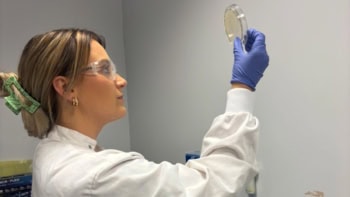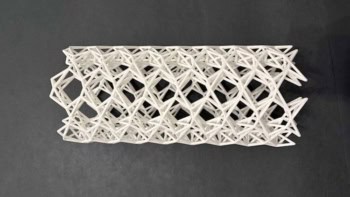
A new antimicrobial coating made of silver and ruthenium can kill multi-resistant pathogenic bugs. The substance, dubbed AGXX®, has been tested on contamination-prone surfaces inside the International Space Station, which is an extreme, closed, hostile habitat where bacteria develop particular defence mechanisms against antibiotics and detergents.
“On the ISS, bacteria develop a thicker cell wall, for example, or highly express virulence genes,” explains Elisabeth Grohmann of Beuth University of Applied Sciences Berlin, who led this research study. “But despite the harsh conditions and these defence mechanisms the AGXX® remains active.”
The microorganisms on a spaceship come from humans themselves – the crew and the helpers who prepared the mission. On Earth, these bacteria are generally harmless, but microgravity and cosmic radiation can increase their virulence and transform them into potential pathogens. These conditions also lower the immune defences of the astronauts, which, when coupled with the psychological stress associated with spaceflight, makes them much more prone to infection.
The bacteria humans carry in fact become hardier, says Grohmann. They develop thicker, protective cell walls and resistance to antibiotics, becoming more vigorous, multiplying and metabolizing faster. Unfortunately, that is not all: the genes responsible for this newfound resilience can readily be shared among different bacterial species as they come into direct contact with each other or via the increasing amounts of biofilm they produce.
Micro-galvanic silver and ruthenium
The new antimicrobial coating is made of micro-galvanic silver and ruthenium, conditioned with ascorbic acid. It can be coated onto any kind of surface, including steel, plastics and wood, and can be incorporated in bead/powder form in creams and lacquers, explains Grohmann.
Another of its advantages is that it is only slightly cytotoxic (it has been declared as a medical product). “No bug-resistance has been detected so far, and this is likely due to the reaction mechanism by which it damages biomolecules, such as DNA, proteins and lipids. These reactions occur via reactive oxygen species (ROS) that penetrate biological cells rather than via released silver ions, which would trigger silver resistance.
Effective against a variety of Gram-negative and Gram-positive bacteria
The researchers tested the AGXX® on both Gram-negative and Gram-positive bacterial strains, including MRSA, Enterococcus faecalis, Staphylococcus epidermidis, pathogenic E. coli (ESTEC), Pseudomonas aeruginosa, Acinetobacter baumannii and Legionella. It was active against all these but to a different extent.
The effects of AGXX® are similar to bleach, except that it is self-regenerating so it never gets used up, says Grohmann. “As well as all kinds of bacteria, it also inhibits the growth of certain fungi, yeasts and viruses. And after six months of exposure on the ISS, no bacteria were recovered from AGXX®-coated surfaces.”
After 12 and 19 months, the researchers say they recovered a total of just 12 bacteria. This is 80% less compared to those from bare steel, which was used as a control. A conventional silver antimicrobial coating also tested only reduced the number of bacteria by 30% compared to steel.
Contact effect
Since the coating works through contact with bacteria, its effectiveness can decrease over longer periods of time though, says Grohmann. The antimicrobial test-materials are static surfaces, on which dead cells, dust particles and cell debris can accumulate, interfering with the direct interaction between the coating and bacteria, she explains. The isolates obtained from such surfaces after 19 months are able to form immunity-invading biofilms and are resistant to at least three antibiotics, including sulfamethoxazole, erythromycin and ampicillin. They are also able to share the genes responsible for resistance between them.
“However, by simply rinsing off the dead cells and dust particles with water, the efficiency of AGXX® can be fully recovered, at least on Earth where this was done successfully,” insists Grohmann.
“Immunosuppression, bacterial virulence, and therefore infection, increase with spaceflight duration, so we must continue to develop new approaches to combat bacterial infections if we are to attempt longer missions in the future – to Mars and beyond.
“AGXX® shows promise because it is already used on Earth in cooling towers to keep water free from contaminants and in water tanks in vans. It is also being tested as an antimicrobial coating in urine catheters and wound dressings, and as an anti-fouling agent on ship hulls.”

Flexible nanotubes pack a punch
Improved filter systems and antimicrobials
The researchers, reporting their work in Frontiers in Microbiology, are now busy developing a prototype water filter system with Uwe Landau’s team at Largentec GmbH Berlin and Rainer Haag’s group at Free University Berlin. This filter consists of AGXX® and functionalized graphene oxides (GOX) and it should be more durable and longer lasting than existing filters. A similar system is planned for air filters (for air-conditioning).
“We are also testing AGXX® and GOX as antimicrobials in a four-month isolation project (SIRIUS habitat, IBMP Moscow) co-funded by ESA and NASA,” Grohmann tells Physics World. “This project started on the 19thof March.
“The next steps in our work will be to see if the coating materials can inhibit the germination process of the most resistant life-modes of bacteria – the so-called endospores, she adds. “In addition, we are looking into the molecular stress response of the bacteria that do survive on the AGXX® coating to understand why they survived and what makes them that resistant. We will try and further improve the materials based on the findings of this study.”



